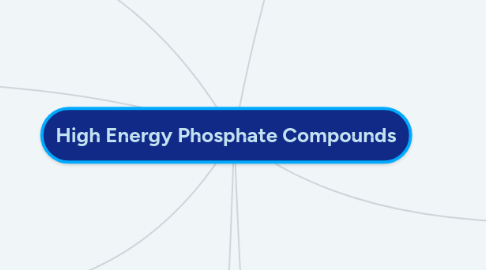
1. Definition
1.1. They are also known as energy rich compounds. Compounds in biological system which on hydrolysis yield free energy equal to or greater than that of ATP. i.e. ΔG = 7.3 kcal/mol. High energy phosphate compounds are not used for long term storage. They are temporary forms of stored energy are used to carry energy from one reaction to another. Bonds are denoted by Squiggle '`' symbol.
2. Properties
2.1. high-energy phosphate reactions can provide energy to cellular processes, allowing them to run
2.2. high-energy phosphate reactions can couple processes to a particular nucleoside, allowing for regulatory control of the process
2.3. high-energy phosphate reactions can drive a reaction out of equilibrium (drive it to the right) by promoting one direction of the reaction faster than the equilibrium can relax.
3. Formation of high energy phosphate compounds
3.1. During oxidation of substrates (eg. glucose) are formed intermediates with high energy phosphate group
3.2. ATP- the most important high energy phosphate compound and its phosphoanhydride bonds are created in the process of oxidative phosphorylation in mitochondria
3.3. Some energy rich compounds are produced so that phosphate is transferred from ATP to another molecule in the reaction which is catalysed by kinase and high energy bond is preserved
4. ATP- Most important high energy phosphate compound
4.1. Often used for energy transfer in the cell
4.2. ATP is an unstable molecule which hydrolyzes to ADP and inorganic phosphate when it is in equilibrium with water.
4.3. The high energy of this molecule comes from the two high energy phosphate bonds. The bonds between the phosphate molecules are called phosphoanhydride bonds.
4.4. Hydrolysis of ATP is removing or adding one phosphate group interconverts ATP to ADP or ADP to AMP. Breaking one phosphoanhydride bond releases 7.3 kcal/mol of energy. Hydrolysis of ATP is an exergonic reaction.
4.5. ATP is useful in many cell processes such as glycolysis, photosynthesis, beta oxidation, anaerobic respiration , active transport across cell membranes(ETC) and synthesis of macromolecules such as DNA
5. Classification
5.1. Pyrophosphates
5.1.1. Bonds are formed by the condensation of acid groups(mainly phosphoric acid) or its derivatives
5.1.2. eg. ATP. It has 2 high energy di phosphate bonds- phosphoanhydride bonds
5.2. Enol phosphates
5.2.1. Formed when phosphate group attaches to a hydroxyl group which is bounded to a carbon atom having double bond
5.2.2. eg. Phosphoenol pyruvate
5.3. Acyl phosphates
5.3.1. Formed by the reaction between carboxylic acid group and phosphate group
5.3.2. eg.1,3 bis phosphoglycerate
5.4. Thiol phosphates
5.4.1. bond results from the reaction between thiol and carboxylic acid group
5.4.2. Acyl and acetyl compounds
5.4.3. eg. Acetyl CoA
5.5. Guanido phosphates or phophagens
5.5.1. Formed by the attachment of phosphate group to guanidine group
5.5.2. eg. Phosphocreatine
6. High energy phosphate reactions
6.1. ATP + H2O → ADP + Pi
6.1.1. The energy released from the hydrolysis of ATP into ADP is used to perform cellular work, usually by coupling the exergonic reaction of ATP hydrolysis with endergonic reactions.
6.1.2. Energy released- 30.5kJ
6.2. ADP + H2O → AMP + Pi
6.2.1. Energy released- 30.5kJ
6.3. ATP + H2O → AMP + PPi
6.3.1. inorganic pyrophosphate(PPi) is formed by the hydrolysis of ATP into AMP in cells. When a nucleotide is incorporated into a growing DNA or RNA strand by a polymerase, pyrophosphate (PPi) is released.
6.3.2. Energy released- 40.6kJ
6.4. PPi + H2O → 2 Pi
6.4.1. Energy released- 31.6kJ
